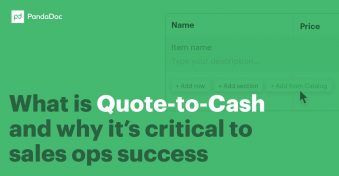What is CPQ? CPQ is short for “Configure, Price, Quote,” and the term is typically used when referencing the sales process and quoting software involved in that process.
When a lead asks for a quote from a business based on the list of services or products that the business sells, sales reps need to configure that quote, compile all pricing information, and quote the total cost of labor and goods to the lead.
But this process isn’t as easy as it sounds.
In this article, we’ll talk about every aspect of CPQ, including giving a CPQ definition, explaining why it matters, and discussing software tools you can use to streamline your sales process so that it scales with your business.
Let’s jump in!
01. What does CPQ stand for: An in-depth overview
The CPQ process is closely tied to the sales pipeline and the quote-to-cash cycle.
Divining the full CPQ meaning, starts with its three basic parts:
1. Configuration
Many companies are looking for something other than an out-of-the-box product. That’s where the configuration part of configure, price, quote comes in.
In this first stage of the process, your sales reps may need to create product configurations customized to the individual customer’s needs.
Configuration and flexibility are at the heart of many pre-sales conversations. Potential customers are looking for the perfect product to suit their needs.
Often, they don’t need to know about every single product offering you have or every single feature that might be available.
It’s up to your salespeople to demystify the product and build a customized solution that offers precisely the functionality customers need to get the job done.
2. Pricing
Many organizations can set up a basic feature selection to handle regular customer needs. From the back office, this is typically done using a pricing catalog.
It’s even possible to create feature packages for products and services. Think of subscription services that offer bronze, silver, and gold packages, for example.
By choosing between those three tiers, many customers will find exactly what they need without a rep getting involved.
But that won’t be a good solution for every customer. Configurable products will require customized pricing for leads that can’t find their solution in one of those predefined categories.
PandaDoc offers a dedicated pricing module for this where you can add catalog items and input key information for those items (SKU, Product Name, Price, Description) for fast and easy access.
That way, adding products to the pricing table in the editor is fast and simple.
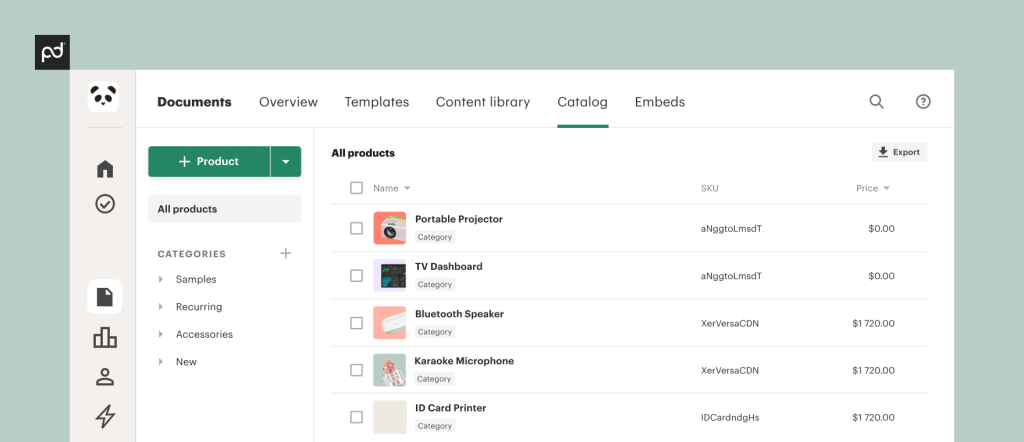
Sales reps need to be able to adapt to customer needs, but this level of customization can prohibit any automation or standardized pricing solutions that your team might use when creating accurate sales quotes.
Reps will also need to be able to include discounts, swap in product features, and add upsells or concessions to the final total in order to generate accurate pricing.
3. Quotes
Once the pre-sales process is completed, reps need to compile all important information and send it out within a reasonable amount of time.
While it might seem simple, the quoting process can become very complex.
Because quoting complex products and services can be a heavily manual process, it’s possible for reps to miss details or quote inaccurate numbers, leading to profit loss or a poor customer experience.
A CPQ platform or similar quoting tools can help to eliminate those errors before they even start.
Using the pricing catalog from the previous section, reps building quotes with PandaDoc would simply add pre-defined line items to the pricing table.
All of the pricing and related inventory would be added to the quote automatically.
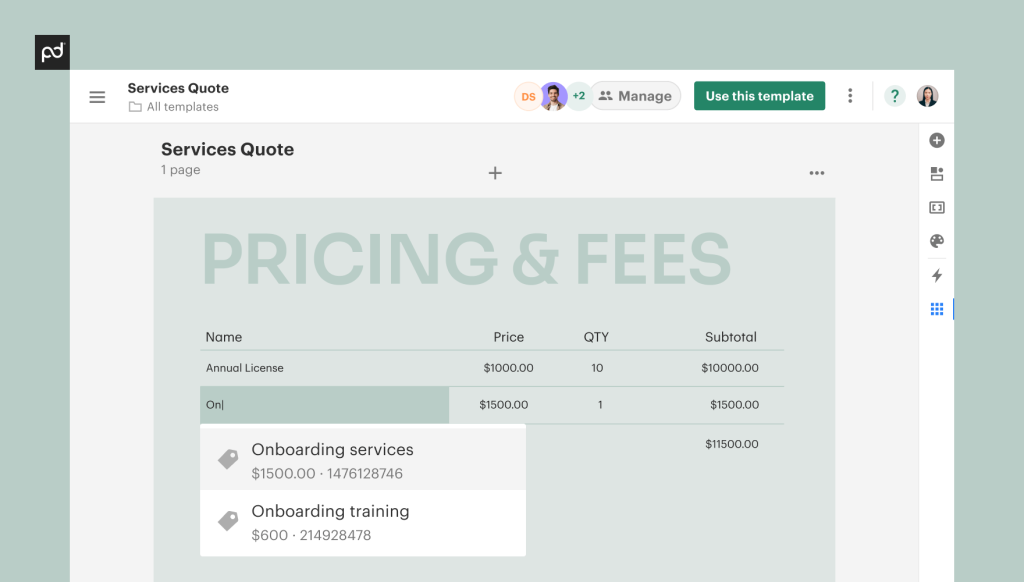
Regardless of how you choose to resolve input issues, quotes must be error-free and compliant with all pricing rules before it goes to the customer.
Many companies have internal business processes to act as safeguards against these errors, including internal reviews and approval workflows that must be completed to confirm document value.
Unfortunately, these processes take time and elongate the sales cycle, which can be a major disadvantage if you’re operating in a competitive market where a competitor can take advantage of your slow response time.
Fortunately, that’s another area where PandaDoc can help. Sales teams can use PandaDoc to automate processes and speed up deals.
PandaDoc CPQ can help you control and manage sales, and real-time reporting makes tracking and follow-ups swift and simple.
02. How CPQ can help solve problems with sales growth
So, why use configure, price, quote in your business?
Well, the answer lies in the issues that often occur as organizations try to scale their sales.
As businesses grow and products become more complex, sales teams see their workloads increase exponentially.
When this happens, manual processes become much more difficult to scale.
Rather than spending their time chasing new leads and closing deals, reps might be stuck working with spreadsheets and sending emails.
These manual tasks also result in much longer sales processes, lost deals, and an elongated pipeline.
If reps are spending too long to finish up one deal and you have a backlog of new leads or inbound contacts, those prospects may not wait long before browsing competitors for an equivalent product.
According to data from a McKinsey Global Institute report, salespeople often spend less than 40% of their time actually selling products.
A lack of data about the products that are actually being sold, what pricing concessions are being made, and which features or services customers actually use also means that your team will reach a bottleneck where it’s difficult for growth to continue.
Adopting the CPQ process and supporting it with appropriate configure, price, quote software is one of the most effective ways to get back on track.
However, in order to do that, you’ll need to find a CPQ solution that can help your team succeed.
03. What is a CPQ tool?
A CPQ tool is used by businesses to create products and services quotes that include varying feature options.
By using rules-based programming, a CPQ tool can be configured to consider and implement different variables that will impact the overall profit of those products or services.
Some examples include companies that offer recurring billing models, subscription pricing, and other revenue methods.
As a result, you get error-free pricing that accommodates a multitude of account quantities, optional product features, discounts, customizations, and incompatibilities.
For instance, CPQ software can generate Service Level Agreements (SLAs) that are customized according to customer-specific information. And then quickly iterate to adjust a quote based on a change request.
A CPQ tool can take the role of bespoke proposal software by creating professional and personalized business proposals using pre-built templates with customizable formatting.
This works by automatically pulling your CRM data, including relevant information on products and services, and adding it directly into your documents.
CPQ software breaks down silos between departments, so that sales, legal, manufacturing, finance, and development can work together more seamlessly.
Read on to learn about what the CPQ process is.
04. What is the CPQ process?
The CPQ process is a way of approaching the sale of products or services whereby you customize the offering to the individual customer’s needs.
However, there’s more to the CPQ process than configure, price, and quote.
You also need to generate a compelling proposal, collaborate with your prospect to reach agreement and deliver on what you promised them.
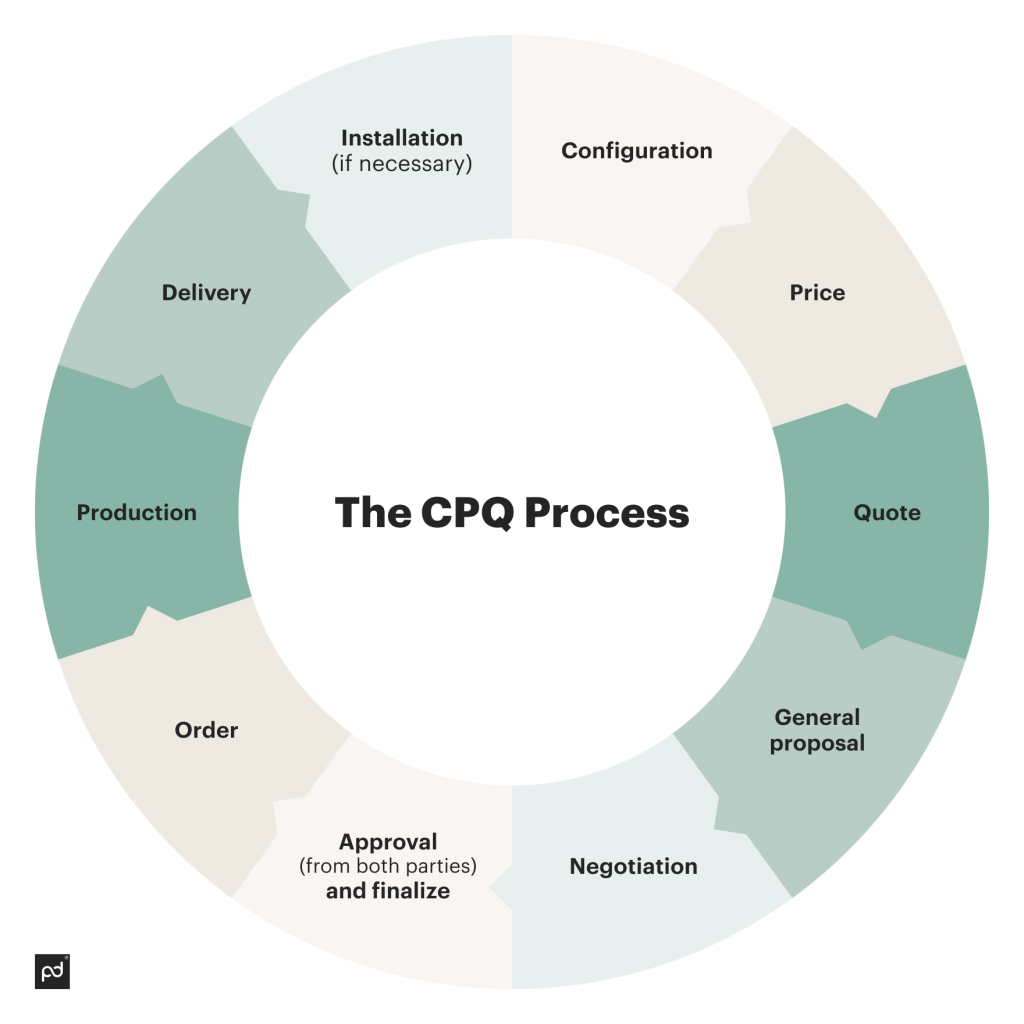
A more detailed set of CPQ process steps in a B2B environment typically looks like:
- Configuration
- Price
- Quote
- Generate proposal
- Negotiation
- Approval (from both parties) and finalize
- Order
- Production
- Delivery
- Installation (if necessary)
The CPQ process that doesn’t involve salespeople—because the business sells directly to consumers—is shorter and usually cut out steps four, five, and six.
05. Benefits of CPQ software
So far, we’ve talked about the CPQ process and how CPQ tools can help you create a more optimized and customer-centric sales process, but the benefits don’t stop there.
As a sales tool, CPQ systems can have a major impact on rep workflow and customer relationship management.
A properly configured CPQ software tool can deliver the following benefits:
- Streamlined proposal generation
- More accurate quotes
- Increased close rates
- Opportunities to add additional revenue streams
- Improved lead conversion
- Faster sales cycles
- Access to real-time sales data
- Accelerated onboarding for new reps
- Better pipeline management
- Improved forecast accuracy
At PandaDoc, our customers see incredible results in document creation time, close rate, and the number of documents that reps complete in a month.
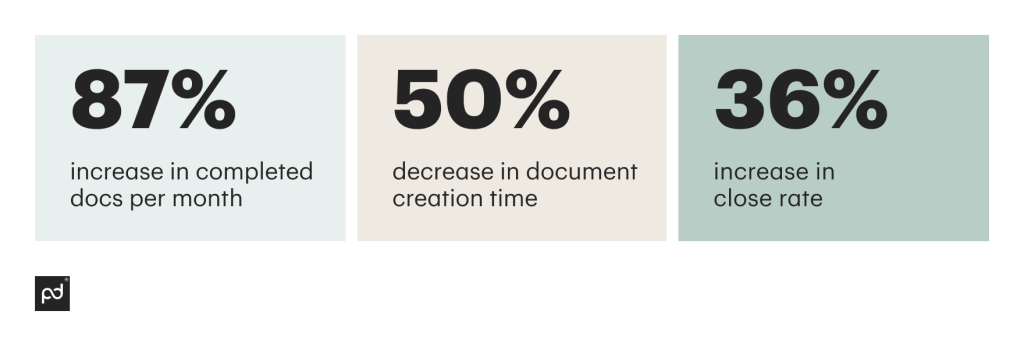
Added to those benefits, CPQ tools typically provide data surrounding what products are selling and how often, you can use them to determine which configurable product combinations align with customer demand and keep them in the back office or stockroom.
06. Examples of scenarios where CPQ is needed
There’s a few scenarios where you should consider CPQ as an addition to your business’s processes. Here are five of the top ones:
Limited workforce
If you’re working with a limited workforce, removing manual processes to generate sales quotes and deliver product configuration assurance via a CPQ tool can help significantly.
Without a CPQ tool, businesses are a bit stuck due to process bottlenecks, and therefore struggle to scale.
The right software automates accurate quotes and ensures that your workforce doesn’t spend valuable time on manual data entry.
Decreasing revenue
A dip in sales could indicate you need to streamline how your business generates sales quotes.
By using CPQ applications, you can implement and drive more efficient sales processes throughout your business.
This means increasing the number of accurate and quality sales quotes to customers, therefore growing your business for more revenue.
With CPQ’s automated processes, you can generate quotes more quickly and take the pressure off your teams, so they can focus on tasks that increase revenue, such as customer calls and prospecting opportunities.
Numerous misquotes
Sending inaccurate sales quotes during prospecting is one of the biggest faux pas.
To project an image of a professional business, CPQ steps in to configure whichever variable you need to demonstrate.
When your team builds quotes, it’s simply a case of using a customized template, routing it to the relevant team members for approval, and then forwarding to customers, perhaps using electronic signature software, for quick responses.
In this vein, your sales teams gain the confidence to better drive deals, as they know that CPQ creates perfect quotes every time.
Reduced sales performance
If your operation is experiencing low sales performance, or you want to increase sales to scale, implementing CPQ is the answer.
CPQ enables your sales team to focus more on actual selling, and not on generating quotes.
After all, software can take care of quote generation, but not selling to customers—that must be undertaken by experienced humans!
To take control of your sales deals, empower your team to make smart decisions by leveraging intelligent data.
With CPQ, you get real-time reporting and analytics to understand how customers engage with your documents and reduce potential bottlenecks.
07. Implementing CPQ
Now that we’ve talked about the CPQ process, CPQ software solutions, and when you might want to implement these tools into your standard workflow, let’s get into the specifics of how to take the next steps:
Step 1. Evaluating CPQ solutions & your tech stack
Any CPQ software that you consider will need to coexist with other digital tools that you use to drive business.
If you have an ERP system or a CRM platform, finding a CPQ solution that aligns with those other apps and systems can help you get a more holistic view of your customer and their needs.
From there, you can locate optimization opportunities and continue to refine your product offering.
The ability to integrate with your tech stack will vary based on the tools you use and their in-built functionality.
Some CPQ solutions may be more focused on being an all-in-one tool that captures all customer data while tools like PandaDoc can offer native integrations for popular CRM and accounting platforms.
Many modern CPQ solutions can also integrate with e-commerce platforms so that reps can even work with customers to build offsite product configurations at the right price.
Step 2. Standardizing your sales process
Before implementing a CPQ solution with your tech stack and your sales team, keep in mind that you’ll need to take steps to create a modular sales solution that makes sense for your entire organization.
CPQ tools won’t help you if you don’t know what products you want to sell or how to price them.
If you fail to add key products into the system, reps won’t be able to add them to their quotes without using manual processes.
Outside of your standard inventory, you’ll also have to factor in “intangible” items like product/service discounts and freebies so that they can be added to quotes and pricing in a simple and logical way.
You might also want to consider when and how these tools can be used on quotes and provide the appropriate training opportunities to anyone with access to them.
PandaDoc can help your sales team adopt CPQ with ease
With PandaDoc, you’ll find integrations to most major CRMs, as well as key payment gateways like Stripe, Square, and PayPal, but the tool is more modular and easier to integrate.
On top of that, PandaDoc is one of the most well-known eSignature solutions on the market today, so you can close deals with signatures and payment in record time.
With PandaDoc, you’ll get quality, flexibility, and legally binding eSignatures all at an affordable price that scales with your business operations.
All of that makes it simple to make the most of the configure, price, quote process.
Now you know the answer to the question “what is CPQ”? Start reaping the benefits with PandaDoc.
To find out more, and learn how PandaDoc can help you with CPQ (or any other sales process), schedule a 15-minute demo today!
Frequently asked questions about CPQ
-
CPQ can be implemented as part of a CRM (Customer Relationship Management) system, and some software solutions deliver this.
Having CPQ as part of wider CRM is a natural route to take, as many CPQ conversations are informed by CRM data.
Merging a CRM platform that manages data and customer interactions with a CPQ tool that supports sales teams streamlines processes and helps you keep all information in one place.
-
Choosing between the CPQ tools on the market today is about what your business needs.
Some tools, like PandaDoc, use onboard document editors and templating options for fast and easy quoting. Other tools, like Quotewerks, rely heavily on the power of a product database.
-
As with all automation tools, CPQ software can help you build a reliable system that you can use to create standardized pricing and keep everyone on the same page. While it can help you improve your sales workflow and quoting process in those ways, though, it won’t be able to help if you lack an understanding of what products you want to sell and how they need to be configured.
-
For the most part, yes. Most configure, price, quote software is industry agnostic.
For most CPQ tools, it won’t matter what products or services you add to the database. The tools and functionality of the software tool will work the same for every business and in nearly every scenario.
-
Not every CPQ tool will help you collect payments.
Some CPQ tools, like PandaDoc, come equipped with a payment gateway so that you can quote and bill at the same time.
On the other hand, Salesforce CPQ relies on Salesforce Billing — a completely separate module within the Salesforce platform — to handle payments and invoicing. Other CPQ systems may have no payment gateway functionality.
-
In a nutshell, customer relationship management (CRM) software handles customer profiles and keeps track of any customer orders and correspondence.
CPQ systems help you build and quote orders for customers that exist within your CRM database.
If you don’t already use a CRM platform, some CPQ tools may provide support or integrations with CRM solutions. PandaDoc, for instance, integrates with Salesforce and other platforms.
The Salesforce CPQ integration is one of the most popular because this powerful combination completely eliminates copying and pasting customer data into important sales documents. This means that your teams can consistently and rapidly produce quality collateral.
Users love the real-time document status updates delivered via the Salesforce dashboard that easily determine when prospects are interacting with received documents.
Because PandaDoc integrates with all Salesforce Sales Cloud editions, your business can effortlessly switch from Salesforce Classic to Lightning without losing any data in the process.
Originally published February 21, 2018, updated March 7, 2023
Disclaimer
PandDoc is not a law firm, or a substitute for an attorney or law firm. This page is not intended to and does not provide legal advice. Should you have legal questions on the validity of e-signatures or digital signatures and the enforceability thereof, please consult with an attorney or law firm. Use of PandaDocs services are governed by our Terms of Use and Privacy Policy.


